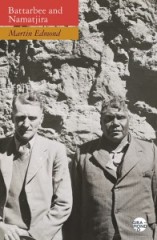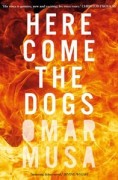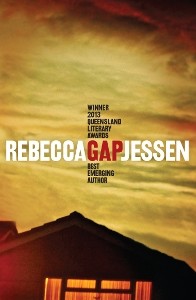 Battarbee and Namatjira
Battarbee and Namatjira
by Martin Edmond
Giramondo
ISBN 9781922146687
Reviewed by GRACE COCHRANE
Martin Edmond is a very engaging storyteller. He involves his readers as if they are taking part in a conversation or reading from the same page in his research. He is also a well-known, award-winning writer of poetry, essays, and screenplays, as well as histories and memoirs—including biographies, so he knows what he is doing.
But there are stories and stories. Some are based solely on evidence – if it exists. Many are constructed from partly remembered or recorded information where the gaps are filled with imagined connections and interpretations. Edmond has done both, in works of fiction and non-fiction. Dark Night: Walking with McCahon (2011), for example, is a very believable but completely imagined account of an actual occasion when New Zealand artist Colin McCahon went missing in 1984 at the time of his exhibition in Sydney.
In this publication, however, using an informal literary writing style, little is imagined or interpreted. Edmond tells it as it is: bringing together the shared story of artists Rex Battarbee and Albert Namatjira as it has been documented from different points of view, and placing it within the changing political and cultural contexts of their time. This unusual double biography of two artists focuses not so much on their separate personal stories, but on the relationship between them as they pursued their interest in depicting aspects of the Central Australian landscape in watercolour paintings: today we recognise immediately their blue skies, distant purple hills, red rocks, ochre-yellow soil and white tree-trunks. In the 80 years of Rex Battarbee’s life from 1893-1973, and the 57 years of Albert Namatjira’s life within that time from 1902-1959, they worked together over a period of about 30 years, their professional activities ranging from exploring painting techniques to managing their marketplace. Namatjira became famous for his representation in a European watercolour genre of the land he belonged to as an Indigenous Australian, while Battarbee, lesser known at the time as an artist, was crucial as a catalyst.
Edmond not only draws deeply on major publications by scholars and historians about the artists and their work, but also on a number of archival documents in public and private collections, including some important unpublished sources: one of these is Rex Battarbee’s collection of diaries from 1928 until the mid-1950s. Many well-known writers, linguists, artists, philanthropists, prospectors, collectors, ethnographers, missionaries and historians – some associated with the building of the railway and the overland telegraph line – who visited, or were associated with, Hermannsburg in these years, are drawn into the story. Among them are Baldwin Spencer, J.M Stuart, R.M. Williams, Carl and Ted Strehlow, Charles Mountford, Pastor Albrecht, Frank Clune, Jessie Traill and Una Teague. Within the intriguing accounts of the backgrounds, interests and professions of these many and varied people, their documented voices are extracted as quotes and collaged seamlessly, in italics, into the text. Although the sources for these segments are introduced as part of the story and identified at the end – not in a list but in another narrative that discusses their significance and sometimes, discovery – disconcerting for some readers is the absence of footnotes to the quotes that lead to those sources. But it works for me. Despite the non-academic format I was not only carried along by the story but convinced by the authority of the text.
While it is evident that Edmond visited collections and looked closely at the works of both artists that are so central to the story, it transpires that he was unable to include images of Namatjira’s paintings in the book. He found that through a complex sequence of events the copyright in Namatjira’s work was held not by his descendants but by his dealer/publisher from the 1950s. Legend Press refused permission to use images from two key collections, so Edmond’s book is illustrated only with black and white photos of the artists themselves. These too, are described in the narrative rather than through captions, though listed at the end.
There are no explanations for these formatting decisions, and neither does Edmond explain why he became interested in the topic in the first place. He is obviously closely absorbed in the story but clearly prefers to provide us with evidence rather than interpret it. Curiosity made me dig deeper and this revealed a preliminary document, Double Lives: Rex Battarbee & Albert Namatjira, which was Edmond’s doctoral submission in 2013.[1] What became the published book is the ‘creative work’ component of the thesis, and the initial abstract for the overall submission and later conclusion to the explanatory exegesis, provided the background I was seeking (and following Edmond’s example I will not refer to page numbers within it for the following extracts!). In his introduction to the exegesis he notes of his rationale:
Biography is a primary means of re-construction of the past and, when artists are the subject, that inevitably means a re-evaluation of what they made. We tend to forget how some of those whose work we take for granted these days were once ignored; and also that among those we now celebrate are some who will not later be remembered: but that is where I like to work, in the terrain between remembering and forgetting. It is here that what is lost may be found again; where what has been occluded may come back into the light; where the familiar can be made strange and the strange, familiar.
Edmond became interested during previous research for The Supply Party, his 2009 book about Ludwig Becker, the German-Australian watercolour painter who died during the Burke and Wills expedition of 1860-61. He began to wonder if Battarbee had ever seen Becker’s work, which seemed to him to prefigure that of Namatjira. He discovered that little information existed about Battarbee, and concluded that:
If Battarbee was a cipher, Namatjira … had become an icon: that is …They were both, rather than themselves, representative of notions espoused by others. Soon, a casual inquiry morphed into something more like a mission: I wanted to restore Rex Battarbee to a place in the history of his times and ours; and to retell the story of Albert Namatjira so that it could be understood, not as polemic or example or parable, but as a lived life.
And this is what he proceeds to do. Edmond makes sure readers are first conversant with the background to the story, but without interpretation, saying:
In my view such inquiries by their very nature privilege story-telling over analysis, information over speculation, practise before theory; narrative has to take precedence because without knowing what has happened, how can we begin to understand what it might mean? A deliberate refusal, in the first instance, of interpretative strategies might seem idiosyncratic, indeed impractical, but I felt that any approach that tried to deconstruct earlier versions of what Namatjira ‘meant’ would only exacerbate the problem. The important thing was to establish, as far as possible, the truth of the matter.
Edmond’s introduction takes us directly into three key contextual frameworks: that of the Arrernte people of Central Australia, of whom Namatjira was part; the Lutheran church which established the Hermannsburg mission near Alice Springs, where he was born; and the anthropologists who started to document Aboriginal life and customs, often while travelling for another purpose. This is followed by a chapter on Battarbee’s early life: born in Warrnambool, he had served in World War 1 and had received severe injuries including damaged lungs and a useless left arm with a paralysed hand. Next is a chapter documenting Namatjira’s origins from his birth at the Hermannsburg Lutheran Mission into the Western Arrernte-speaking people from near Alice Springs, and where he grew up in a Western evangelical community which sought to provide sustainable living conditions for its members, while having little tolerance for the practice of indigenous traditions. From this point, further chapters cross the 1920s to the 1950s, following the interweaving paths of both artists. In talking about their work, Edmond clarifies in the abstract to the thesis that he means: ‘ … both the artefacts they made and the traditions they inherited, transformed and passed on to succeeding generations’.
After three years in hospital following the war, Battarbee studied commercial art, but then began painting landscapes, using practical and quick-drying watercolours, partly because his damaged hand was sensitive to oil and turpentine. Namatjira married young, controversially, and left the Mission for some years to work on outstations and as a camel driver. In 1928 Battarbee set out with his friend John Gardner to Queensland where they painted landscapes for later sale in an exhibition in Adelaide. In the following years they made further trips, this time to Central Australia where they met people at Hermannsburg, including, in 1932, a ‘camel-man’ who showed interest in what they were painting. This was Albert Namatjira, who was already drawing and poker-working artefacts for the Mission, and who started asking for painting supplies following another visit in 1934.
In Central Australia Battarbee evolved his own layering technique for applying coloured pigments to achieve ‘luminosity’, identified in his work as early as 1932 in a painting of Bitter Springs Gorge. In 1936 when he returned alone, eventually to stay, he began to work closely with Namatjira who had already started painting, encouraged by the example of several visiting artists, and who sought his assistance. Recognising both his interest and his talent, Battarbee agreed to teach him this plein-air style of painting, including his own technical secrets. Namatjira responded by telling Battarbee tribal stories of the lands they visited. As they worked together, and as Namatjira’s work started to sell, Battarbee became his manager as well as mentor, as they dealt with ‘the practicalities of making art in a remote area in the middle years of the twentieth century’.
The story takes us though their shared excursions into the land; Namatjira’s introduction to photography, which Battarbee used; and the development of what became known as the Hermannsburg School of painting, which continues today. As well as discussions about achieving ‘luminosity’, using ‘colour’ and ‘painting from memory’, also included are the controversies in the art world about the value or otherwise of Indigenous artists adopting or ‘aping’ this foreign style of painting, and whether or not what appeared to be conventional ‘side-on’ landscapes also carried tribal meanings or anthropomorphised representations. As Edmond notes: ‘The question of who sees what is raised every time we look at Namatjira’s painting; and especially when we consider the possibility that he encoded in his art information that not everyone could be expected to know.’
Further issues include the emergence of unscrupulous dealers and the commodification of work made by other artists, the financial expectations according to custom by Namatjira’s extended family as he became famous and well-off and the changing role of both the Mission and Battarbee during this time. Also documented are the concerns associated with government policies for assimilation, such as Namatjira’s frustration at earning money and being taxed but not being allowed to buy a car, build a house in Alice Springs because of a curfew for Aboriginal people or lease grazing land where he also wanted to paint. His much-publicised ‘citizenship’ in 1957 removed him and his wife, Rubina, but not his family, from the register of wards of the state. However, now with access to alcohol along with all the remaining contradictions in his life, including having to apply for a permit to visit his traditional lands, this frustration eventually resulted in his death, a conclusion recognised with shame and guilt by those growing critical of such conditions.
Battarbee and Namatjira is an immensely readable book, sad but celebratory. Most readers will be aware of some of the story and many of the characters, events, issues and places. But this narrative provides details and insights that I doubt can be found together elsewhere. Martin Edmond’s thesis becomes a reality, in showing that: ‘Albert Namatjira, rather than a wanderer between worlds, was a bridge; that was what he painted and that was where he was torn apart and died; and we are still contending over the bones on the bridge that he made’, and that ‘Rex Battarbee was his friend, his teacher, his guide—and his dealer; he too was torn apart and abandoned to the anonymity of a dead hero; the relationship of artist and dealer is the spine of this story.’ I think Martin Edmond has achieved what he intended. As he concludes in his thesis:
Story-telling is an ancient art and one of its primary functions, throughout its long history, has been to furnish an audience with the material out of which they can come to their own conclusions, construct their own interpretation, find their own understanding.
[1] All quotes are from: Martin Edmond, Double Lives : Rex Battarbee & Albert Namatjira, Thesis for a Doctorate of Creative Arts, The University of Western Sydney, 2013.
GRACE COCHRANE AM is an independent curator and writer, who has specialised in the field of contemporary crafts for over 40 years. She wrote The Crafts Movement in Australia: a History (UNSW Press 1992), and has written or contributed to a large number of other publications. A former museum curator, she has been a member of many boards and continues to examine post-graduate submissions, contribute to conferences and develop exhibitions. She has an MFA and PhD (1999) from the University of Tasmania and a D.Litt from the University of NSW (2007).
 Chloe Wilson’s first poetry collection, The Mermaid Problem, was commended in the Anne Elder Award and Highly Commended in the Mary Gilmore Award. She won the 2014 Val Vallis Award for Unpublished Poetry and was Highly Commended in the 2014 Manchester Fiction Prize.
Chloe Wilson’s first poetry collection, The Mermaid Problem, was commended in the Anne Elder Award and Highly Commended in the Mary Gilmore Award. She won the 2014 Val Vallis Award for Unpublished Poetry and was Highly Commended in the 2014 Manchester Fiction Prize.







